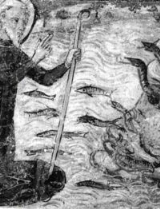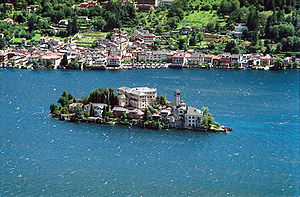
Julius of Novara
Encyclopedia

Missionary
A missionary is a member of a religious group sent into an area to do evangelism or ministries of service, such as education, literacy, social justice, health care and economic development. The word "mission" originates from 1598 when the Jesuits sent members abroad, derived from the Latin...
priest to northern Italy
Northern Italy
Northern Italy is a wide cultural, historical and geographical definition, without any administrative usage, used to indicate the northern part of the Italian state, also referred as Settentrione or Alta Italia...
.
His cult is centered at Lake Orta
Lake Orta
Lake Orta is a lake in northern Italy west of Lake Maggiore.It has been so named since the 16th century, but was previously called the Lago di San Giulio, after Saint Julius , the patron saint of the region; Cusio is a merely poetical name...
in the Novarese
Province of Novara
Novara is a province in the Piedmont region of Italy. Its capital is the city of Novara.It has an area of 1,339 km², and a total population of 365.156 . There are 88 communes in the province.-External links:*...
highlands, and in particular on the island which has been named for him since at least the eighth century, Isola San Giulio, and where his presumed relics are preserved in the crypt, called scurolo, of a basilica dedicated to him.
Few facts are known about his career. In the earliest Vita
Hagiography
Hagiography is the study of saints.From the Greek and , it refers literally to writings on the subject of such holy people, and specifically to the biographies of saints and ecclesiastical leaders. The term hagiology, the study of hagiography, is also current in English, though less common...
, which dates from no earlier than the eighth century and is of a character as much legendary as historical, the account of his life is interlaced with that of his brother Julian (Giuliano), a deacon
Deacon
Deacon is a ministry in the Christian Church that is generally associated with service of some kind, but which varies among theological and denominational traditions...
whose name is similar enough to suggest that they may have been the same person, but now we know (thanks to recent archaeological finds in Gozzano's previous parish church, S. Lorenzo) that they both existed. The Roman Martyrology
Martyrology
A martyrology is a catalogue or list of martyrs , arranged in the calendar order of their anniversaries or feasts. Local martyrologies record exclusively the custom of a particular Church. Local lists were enriched by names borrowed from neighbouring churches...
commemorates only Julius. It has been said the Julius' name was recited as part of the Ambrosian Rite
Ambrosian Rite
Ambrosian Rite, also called the Milanese Rite, is a Catholic liturgical Western Rite. The rite is named after Saint Ambrose, a bishop of Milan in the fourth century...
during the fifth and sixth centuries; however, it has also been claimed that this Julius referred to Pope Julius I
Pope Julius I
Pope Saint Julius I, was pope from February 6, 337 to April 12, 352.He was a native of Rome and was chosen as successor of Mark after the Roman seat had been vacant for four months. He is chiefly known by the part he took in the Arian controversy...
.
Julius and Julian may have been Greeks
Greeks
The Greeks, also known as the Hellenes , are a nation and ethnic group native to Greece, Cyprus and neighboring regions. They also form a significant diaspora, with Greek communities established around the world....
who came to Rome
Rome
Rome is the capital of Italy and the country's largest and most populated city and comune, with over 2.7 million residents in . The city is located in the central-western portion of the Italian Peninsula, on the Tiber River within the Lazio region of Italy.Rome's history spans two and a half...
before establishing themselves at Lake Orta. Their legend states that they were educated in the Christian faith by their parents. They are said to have been ordered by Theodosius I
Theodosius I
Theodosius I , also known as Theodosius the Great, was Roman Emperor from 379 to 395. Theodosius was the last emperor to rule over both the eastern and the western halves of the Roman Empire. During his reign, the Goths secured control of Illyricum after the Gothic War, establishing their homeland...
to destroy pagan altar
Altar
An altar is any structure upon which offerings such as sacrifices are made for religious purposes. Altars are usually found at shrines, and they can be located in temples, churches and other places of worship...
s and sacred woods and to build Christian churches. They built one hundred churches, according to their tradition. The ninety-ninth church is said to have been built at Gozzano, and dedicated to Saint Lawrence
Saint Lawrence
Lawrence of Rome was one of the seven deacons of ancient Rome who were martyred during the persecution of Valerian in 258.- Holy Chalice :...
. Julian was buried there. The hundredth church was built by Julius on the island that bears his name; he dedicated it to Saints Peter
Saint Peter
Saint Peter or Simon Peter was an early Christian leader, who is featured prominently in the New Testament Gospels and the Acts of the Apostles. The son of John or of Jonah and from the village of Bethsaida in the province of Galilee, his brother Andrew was also an apostle...
and Paul
Paul of Tarsus
Paul the Apostle , also known as Saul of Tarsus, is described in the Christian New Testament as one of the most influential early Christian missionaries, with the writings ascribed to him by the church forming a considerable portion of the New Testament...
.

